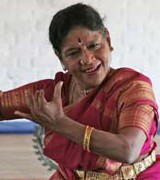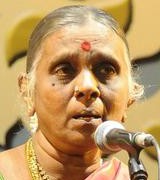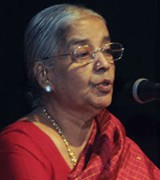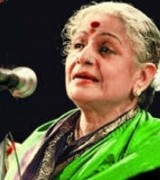COVER STORY
INDIRA RAJAN - A multifaceted laya expert
NANDINI RAMANI

Indira Rajan, a multifaceted, illustrious exponent of Bharatanatyam, hails from a traditional family of dancers and musicians, steeped in the musical and dance lineage of Karaikal. While her grandmother was a renowned Sadir artist, Indira’s mother Sundarakamakshi was a well-known Carnatic vocalist. Indira was born in 1943, and started learning Bharatanatyam as a child from Kutralam Ganesa Pillai. She made her debut when she was barely nine. Moving to Madras in 1955, she honed her dancing skills with Tirugokarnam Kalyanasundaram. From then on she ventured into her artistic career as a performer for a few decades, before establishing herself as a teacher of repute.
Indira was selected to perform in the northern and eastern states of India under cultural exchange programmes of the Tamil Nadu Eyal Isai Nataka Manram. She performed extensively at Chennai, in major festivals in India and toured several countries. She performed at important State functions and in the presence of dignitaries. Apart from composing solo dances, she choreographed dance-dramas on varied themes. Muruga Saranam, Sakti Darisanam, and Kutrala Kuravanji are some of her well known productions. She has also choreographed dances for films. As a teacher-choreographer, Indira has composed many thematic productions for special occasions and for several leading artists. Her dance composition for some of the varnams of her longtime accompanist – mridangam artist Pandanallur Srinivasa Pillai – are quite popular among dancers.
COVER STORY
SUGUNA VARADACHARI - A resourceful teacher
N. RAMANATHAN

In Suguna Varadachari’s long musical journey, a substantial and significant segment has been her service as a member of the teaching faculty at the University of Madras. As her colleague, I feel it has been a significant period for the Department of Indian Music.
In 1984, prior to Suguna’s interview to the post of Vocal Assistant, Prof. Seetha, the Head of the Department, had been concerned about two issues. The position was a hallowed one with luminaries like K. Ponniah Pillai, Valadi Krishna Iyer and Kalidasa Nilakantha Iyer having adorned it. Further, K.R. Lakshmi, whose retirement a few months earlier had occasioned the vacancy, had been an accomplished and highly respected musician, having earned the appreciation of Tiruppamburam Swaminatha Pillai. An able replacement for that position was a matter of concern for Seetha. Apart from a proficient musician and an able teacher, she was also looking for a ‘team person’ – someone who could interact with colleagues in contributing to the other academic activities of the department. Hence she had made discreet enquiries about all the applicants for the post.
SPECIAL FEATURE
SEASON 2015-16 (part 2) - Predictable – with some exceptions
T.T. NARENDRAN

As mentioned in Sruti 377 (February 2016) the musical fare on offer during the 2015-16 season was largely predictable. In this issue I continue on the same note with a few more music concert reviews.
Veteran Alamelu Mani, with her vast repertoire, presents a good number of less-heard compositions. Early on, there was Syama Sastry’s Himachala tanaya (Anandabhairavi). At 81, her voice seems to be in unbelievable condition. She elaborated Jagan-mohini with ease, with Usha Rajagopalan (violin) shadowing her faithfully. Tyagaraja’s Mamava satatam, heard often a few decades ago in D.K, Pattammal’s concerts, made a reappearance. The slow setting of the song was soothing to the ears. Amba paradevate (Rudrapriya, KrishnaswamyAyya) came as a pacemaker. Her classy alapana of Madhyamavati inspired the violinist to give her best, too. Tyagaraja’s Adigi sukhamu was a delight to the ears, neatly embellished with niraval and swaras at the charana line Neekedaya.
THE MS CENTURY
When a peacock danced to her song
THANGAM ANANTHANARAYANAN

I used to call her Kunjakka just as her sister Vadivambal did. I first met her when I was around seven years old. Kunjakka was wearing a beautiful orange sari with a black border that had a kolam-like wavy ‘neli’ pattern. She was so beautiful, and wearing such pretty jewellery – diamond ‘dolaku’ in her ears, a navaratnamala, as well as multiple gold chains. She was also wearing a brooch.
The children of the house missed her so badly when she was away filming for Seva Sadanam that we would cry. When this happened, Sadasivam Mama took us to watch the movie being filmed. The director of the film, K. Subrahmanyam, would occasionally drive us all to Elliots Beach in his ‘open car’. Crowds of people would flock to get a glimpse of Kunjakka on these trips.


